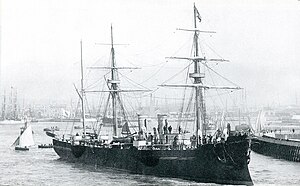Japanese cruiser Unebi

| |
| History | |
|---|---|
| Name | Unebi |
| Ordered | 1883 Fiscal Year |
| Builder | Forges et Chantiers de la Gironde, France |
| Laid down | 17 May 1884 |
| Launched | 6 April 1886 |
| Completed | October 1886 |
| Stricken | 19 October 1887 |
| Fate | Disappeared December 1886 |
| General characteristics | |
| Type | Protected cruiser |
| Displacement | 3,615 long tons (3,673 t) |
| Length | 98 m (321 ft 6 in) w/l |
| Beam | 13.1 m (43 ft 0 in) |
| Draught | 5.72 m (18 ft 9 in) |
| Propulsion | 2-shaft VTE, 9 boilers, 5,500 hp (4,100 kW), 700 tons coal |
| Speed | 18.5 knots (21.3 mph; 34.3 km/h) |
| Complement | 280-400 |
| Armament | list error: <br /> list (help) • 4 × 240 mm (9.4 in) guns • 7 × 150 mm (5.9 in) guns • 2 × 6-pounder guns • 10 × quad Nordenfelt guns • 4 × Gatling guns • 4 × 450 mm (18 in) torpedo tubes |
| Armour | list error: <br /> list (help) Deck: 62 mm (2.4 in) Upper belt: 125 mm (4.9 in) Barbette, Turret, Casement: 150 mm (5.9 in) |
Unebi (畝傍) was a protected cruiser of the Imperial Japanese Navy, designed and built in France by Forges et Chantiers de la Gironde. The Unebi was named after a 199.2 meter tall mountain in Nara prefecture, located near the ancient capital of Asuka. Per Meiji period State Shinto mythology, this mountain was home to Japan's first Emperor, Jimmu Tenno.
Background
Compared with the contemporary Naniwa-class cruisers built for the Japanese Navy in Great Britain, the Unebi was a slightly older design, which included provision for sail propulsion. The design utilized a relatively small displacement in a narrow hull with a disproportionately huge amount of armament.
Service record
Just three months after commissioning, in December 1886, en route from France to Japan, the Unebi disappeared without a trace somewhere in the South China Sea between Singapore and Yokohama. No survivors and no wreckage were ever found, and theories on its mysterious disappearance have led to numerous novels and works of speculative fiction; the prevailing theory was that the design was top-heavy due to its excessive armament and was unstable in rough weather.
The Unebi was officially declared lost with all hands and stricken from the Imperial Japanese Navy list on 19 October 1887. The Unebi is the only case of a ship vanishing without a trace in the annals of the Imperial Japanese Navy. A memorial monument to the missing crew of the Unebi is located at Aoyama Cemetery in Tokyo.
The Japanese government cancelled the production of a second vessel per the same design, and received compensation from the French government. The monies went towards production of the cruiser Chiyoda. However, the Japanese navy was reluctant to continue working with French shipyard after the Unebi disaster, and placed its order for the French-designed Chiyoda to John Brown & Company of Great Britain.
Gallery
-
Unebi in artwork
-
Underway, shortly after departing Le Havre
-
At Le Havre, 1886
See also
![]() Media related to Protected cruiser Unebi at Wikimedia Commons
Media related to Protected cruiser Unebi at Wikimedia Commons
References
- Evans, David. Kaigun: Strategy, Tactics, and Technology in the Imperial Japanese Navy, 1887-1941. US Naval Institute Press (1979). ISBN 0870211927
- Howarth, Stephen. The Fighting Ships of the Rising Sun: The Drama of the Imperial Japanese Navy, 1895-1945. Atheneum; (1983) ISBN 0689114028
- Jane, Fred T. The Imperial Japanese Navy. Thacker, Spink & Co (1904) ASIN: B00085LCZ4
- Jentsura, Hansgeorg. Warships of the Imperial Japanese Navy, 1869-1945. Naval Institute Press (1976). ISBN 087021893X
- Schencking, J. Charles. Making Waves: Politics, Propaganda, And The Emergence Of The Imperial Japanese Navy, 1868-1922. Stanford University Press (2005). ISBN 0804749779


